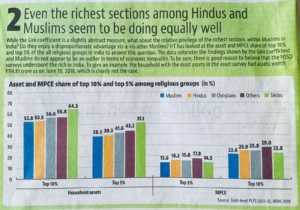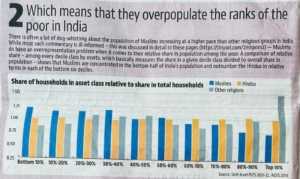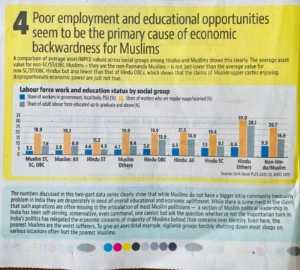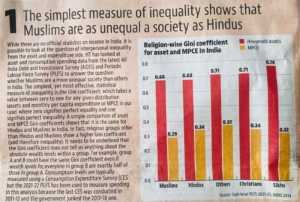Data Limitations in Muslim Education in India (2023)
As indicated earlier, without data on the Muslim population across different segments of the education system, it becomes impossible to calculate enrolment ratios such as gross and net enrolment ratios, adjusted net enrolment ratios, and age-specific enrolment ratios. Unfortunately, the actual and projected population data for the Muslim population are not available beyond 2011, which is also the latest population data available for the total population in India. The 2021 Census is yet to be conducted.
Despite having Muslim enrolment data available since 2006-07 at various levels, such as block, district, state, and all-India levels, there has been a lack of in-depth analysis regarding the education of Muslim children. Crucial indicators, such as dropout, transition, and retention rates, have not been adequately explored. Therefore, the present article aims to shed light on the significant aspects that have not been sufficiently addressed and contribute to a better understanding of the status of Muslim education in India, which is lacking in the existing literature.
The Sachar Committee Report is arguably one of the most comprehensive reports on the socio-economic & educational status of the Muslim community in India. Constituted by the Government of India in 2005, the Sachar Committee submitted its report in 2006, offering several recommendations related to data on Muslim education in India. Some key recommendations from the Sachar Committee regarding data on Muslim education in India are as follows:
- The government should conduct a nationwide survey to collect comprehensive data on the educational status of Muslims in India. This survey must cover all aspects of education, including enrolment, retention, completion rates, school infrastructure, and facilities.
- Data on Muslims in education should be disaggregated by gender, region, and socio-economic status to understand the specific challenges faced by different subgroups within the Muslim population.
- The government should establish a monitoring mechanism to track the progress in improving the educational status of Muslims in India. This mechanism should focus on monitoring the implementation of policies and programs aimed at enhancing the educational status of Muslims.

Even the richest sections among Hindus & Muslims seem to be doing equally well: Hindusatan Times, June 30, 2023
A few of the other significant recommendations concerning the education of Muslims are as follows:
- Measures should be taken to ensure that Muslim children have access to quality education, which includes providing scholarships, constructing schools in areas with a significant Muslim population, and recruiting more Muslim teachers.
- Steps should be taken to address the under-representation of Muslims in higher education, especially in technical and professional courses, which may involve providing special coaching and support to Muslim students preparing for competitive examinations.
Muslim Population in India
In summary, the Sachar Committee’s recommendations emphasize the need for more comprehensive and targeted efforts to improve the educational status of Muslims in the country. By gathering and analyzing data on the educational status of Muslims in India, policymakers can formulate evidence-based policies & programs to address the challenges the Muslim community faces in accessing quality education. The Sachar Committee utilized data from various sources, in addition to State & Central Institutions and Departments. Some of these sources included:
- Census of India
- National Sample Survey Organization (NSSO)
- National Family Health Surveys (NFHS)
- Council of Applied Economic Research (NCAER)
- National Council of Educational Research and Training
- National Institute of Educational Planning and Administration
Since 2006, the All India Higher Education Survey has also been included in the list. With the transition of DISE to UDISE, it has become the sole source of information on India’s entire school education system. In Chapter 2.1, the Sachar Committee emphasized the importance of transparency, monitoring, and data availability as prerequisites for good governance. It recommended the establishment of an autonomous National Data Bank (NDB) to maintain relevant data for various socio-religious categories. The Committee further advocated for the computerization of data and its accessibility on the Internet, as digitization would facilitate monitoring at all levels of governance – from panchayats/municipalities to districts, states, and the Central level.

Share of households in asset class relative to share in total households, Hindustan Times, June 30, 2023.
The status report on the follow-up action on the Cabinet decisions regarding Sachar Committee Recommendations, as of 31st March 2019, mentioned that the Ministry of Statistics and Programme Implementation (MoSPI) had created a National Data Bank (NDB) web page on its website. More than 150 tables related to population, education, health, and labour & employment, in line with Sachar Committee recommendations, were uploaded on the NDB webpage. As suggested by the then Planning Commission and the NITI Aayog, the report recommended locating the Autonomous Assessment and Monitoring Authority in the Ministry of Minority Affairs.

Poor employment & educational opportunities seem to be the primary cause of economic backwardness fro Muslims, HT, 30th June 2023
However, upon visiting the National Data Bank web page, it is observed that the information provided, especially regarding education, is outdated, going back to as old as 2009-10. Census tables lack descriptions, and the link for Census 2011 is non-functional as of 21st February 2023. This raises the question of whether the current form of the Data Bank aligns with the Sachar Committee’s recommended vision. The Committee envisioned the NDB facilitating governance monitoring at district and higher levels. However, educational indicators are not presented below the state level, undermining the basic idea behind developing NDB. The little information available on the NDB webpage is incomplete and outdated, and educational data is not found on the website of the Ministry of Minority Affairs either.
Before examining the status of Muslim education in India, it is essential to briefly consider the Share of the Muslim Population to the Total Population.




